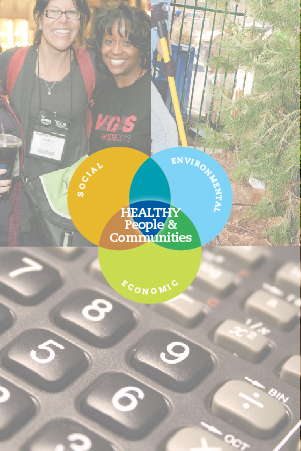By Rex Pringle, Director of RecSports at the University of Tennessee Knoxville
We all know NIRSA members strive to be Leaders in Collegiate Recreation.
Pursuit of this mission also calls us to be leaders in each of NIRSA’s six strategic values.
Recently, members of NIRSA’s Commission for Sustainable Communities and Commission for Equity, Diversity, and Inclusion focused in on the strategic value of sustainability when they attended the Association for the Advancement of Sustainability in Higher Education’s (AASHE) annual conference in Nashville, Tennessee, on October 6–8, on behalf of NIRSA.
While most people readily recognize sustainability as an environmentally-focused value, it’s actually much more multifaceted and far-reaching. NIRSA’s Sustainability groups and recreation programs aim to be the best leaders on our campuses when it comes to creating welcoming environments, being problem solvers, managing student funds, and being the best team players. NIRSA members are committed to promoting university recreation as an integral participant and critical role player in the overall success of our students. And NIRSA members are active in this holistic approach to sustainability, focusing on its importance:
Environmentally
This focus concentrates on helping preserve the earth for future students and generations.
NIRSA members have created partnerships and collaborations in environmental sustainability efforts with our sustainability partners in recycling, communication, carbon footprint reduction, energy conservation and our outdoor programs are champions for green space and better land use on campus.
Socially
This focus concentrates on promoting civility, interaction, inclusiveness, equity and justice for everyone.
Recreation takes an active role in social sustainability with our students and campus community promoting inclusiveness, civility, equity, opportunity, service, and social justice (for examples, see the “You Can Play” videos, adaptive programming at the University of Illinois, and Athlete Allies initiatives).
Economically
This focus concentrates on creating a culture where the cost of higher education is not increasing so rapidly that many students will be unable to attend a college or university.
Recreation departments have traditionally found ways to maintain programs when budgets were either staying consistent or undergoing cuts. Financial stewardship, energy awareness and efficiency, asset management, purchasing, facility design, and resource development have made recreation an economic sustainability leader.
Working with other leaders in higher education
AASHE, with its mission to “empower higher education to lead the Sustainability transformation,” presented the perfect opportunity for NIRSA Strategic Values Commission members to increase our knowledge base, network with potential partners on campus, and interact with other national organization (NASPA, ACPA, HEASC, and the Green Sports Alliance) representatives—all of which provided information on the value and importance that collegiate recreation can play in social, economic, and environmental sustainability.
The conference program had approximately 300 presentations that covered all areas and levels of higher education, as one University President presented on organizational leadership for sustainable education, which showed the long range effects of a number of global climate factors and how the education process needs to adapt and include sustainability in all facets of education.
 While most people readily recognize sustainability as an environmentally-focused value, it’s actually much more multifaceted and far-reaching.
While most people readily recognize sustainability as an environmentally-focused value, it’s actually much more multifaceted and far-reaching.As NIRSA representatives at this conference, we felt reaffirmed and inspired to continue on with our multifaceted approach to sustainability. NIRSA member James Wilkening, Director at the University of Central Florida, reflected: “As a member of the commission for Equity, Diversity, and Inclusion, it became quite clear through the programming of the AASHE conference that Sustainability and Equity are integrally related. The conference certainly did not focus just on environmental factors of sustainability but the social ones that have been previously identified by the NIRSA sustainability commission. For healthy people and healthy communities they must focus on both the environmental and social aspects.”
NIRSA commission members participated in combined presentations with NASPA, ACPA, HEASC and the Green Sports Alliance. The documents and information presented by our committee members showed that NIRSA is currently ahead of some of the other organizations, as we are working to create resources for our constituents. Social sustainability, like James pointed out, is an area where recreational sports stands out as each university works on an inclusive and welcoming environment for everyone.
Taking inspiration and moving forward
Yet, when it comes to our strategic values, our goal is to keep improving; AASHE helped inspire us in this way too. We could see the areas that we had collaboratively and cooperatively worked with at our universities on creating greater sustainability efforts in our campus communities, but we also learned a number of new program ideas which could create new campus partners. Many of our departments partner with the Sustainability Office or the recycling area on campuses; now it is time to branch out and work with the range of campus departments from food services, to transportation and parking areas, to finance & administration.
 NIRSA members attending the AASHE conference.
NIRSA members attending the AASHE conference.Another inspirational presentation came from Justin Mog, from the University of Louisville, on “Trading Parking Permits for Bicycles: The Earn-A-Bike Program as Part of an Integrated Sustainable Commuting Package.” His talk focused on a unique program where participants turn in their parking permit (for two years), sign an agreement to ride a bike to campus, and received a $400 voucher for a bike (or bike products) from an approved bike shop. In addition to an end result of reducing parking congestion on campus, this presentation focused on transportation, health & wellness, and climate mitigation.
The University of Tennessee and their RecSports Department discussed their unique sustainability collaboration with their Athletic Department and Facilities Services: RecSports and Athletics each had 50-meter indoor pools on opposite corners of a street and each pool needed to be drained for repairs and maintenance. As a solution, RecSports paid to neutralize their water and drained their pool first, and, when the work was completed, the water was pumped from the Athletic Department pool into the RecSports pool. This initiative eliminated the need to pay for sending over 1 million gallons of water through the storm sewer system. This sustainability effort provided many environmental and economic gains for both departments and the larger university.
NIRSA’s sustainability in collegiate recreation model states, “Sustainability is meeting the needs of the present without compromising the ability of future generations to meet their own needs” (The Brundtland Commission, 1987). NIRSA and AASHE are making a great effort to create a healthy world that will have a long range future for our students, universities, and community. NIRSA Commission for Sustainability and Commission for Equity, Diversity, and Inclusion members will take the excitement and energy gained from the AASHE Conference and put our increased knowledge and awareness toward additional research, projects and new ideas for the future.
NIRSA members who are interested in becoming involved or would like to learn more can go to the NIRSA Sustainability Community of Practice and get involved in the discussions and resources areas. Please take the time to check out some of our NIRSA member institutions, departments, and the NIRSA Strategic Alliances to review additional sustainability efforts.






